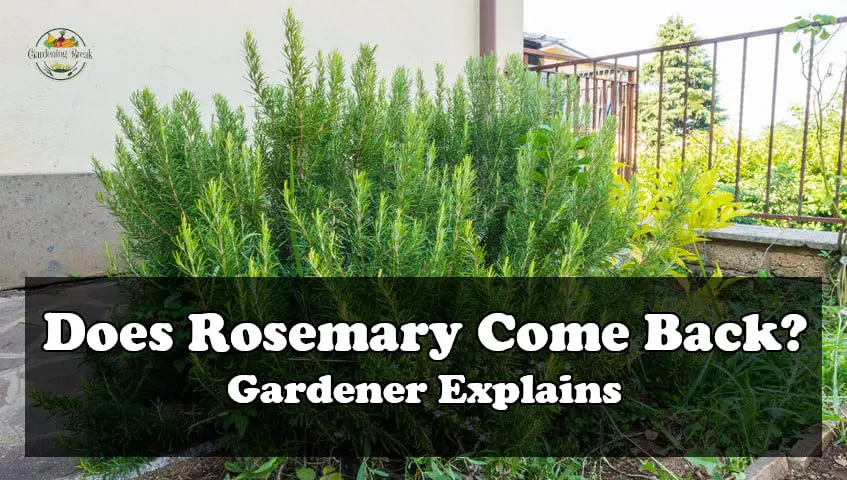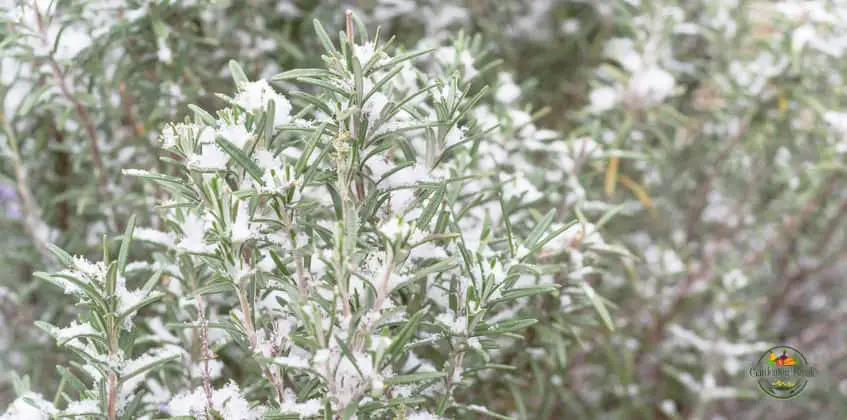This post contains affiliate links.
Rosemary tends to grow a lot slower or even stop entirely in the winter. Especially in areas that experience frost, but will it come back? I have been growing rosemary for a long time, so I can confidently tell you whether or not it will and I have written this article to answer that question.
As a general rule, rosemary will begin to grow again in the spring once the temperature starts to increase. Rosemary is a perennial herb, which means it can live for multiple years. The plant itself can even tolerate some frost, making it able to survive the winter in most parts of the world.
Even though rosemary usually survives the winter and resumes growing in the spring, there is no guarantee. There are a couple of things you should know about to be sure if your rosemary will come back, which I cover in this article. There are also some very simple but effective things you can do to increase the chance your rosemary will come back.

Does Rosemary Come Back Every Year? Explained
Whether or not rosemary will grow again every year depends on where you live, but in the vast majority of the world, it can survive for many years. Even though the plant usually stops growing in the winter, and perhaps even loses some leaves, it will almost always start growing again after the winter.
Rosemary is an evergreen plant, so it doesn’t lose all of its leaves in the winter unless something is wrong with the plant. It might lose some stems and leaves, but for the most part, the plant should look the same all year. It often stops growing in the winter but should resume in the spring.
So rosemary technically doesn’t come back every year, but that is only because it never goes away.
Rosemary is a perennial herb which means it can survive and grow for multiple years (more about that on this link). The rosemary plant itself is frost resistant and can survive cold winters in most parts of the world.
As long as the roots don’t freeze in the winter, the plant will continue to grow in the spring, but they are usually fine since they are protected by a layer of soil. You can read more about that on this link.
As I wrote earlier, even though rosemary usually starts growing again after the winter, there is absolutely no guarantee.
If, for example, you planted a young, small rosemary in the ground just before the winter, it might not survive. The larger and more well-established a rosemary plant or bush is, the more likely it is to survive the winter.
If your rosemary has lost all of its leaves and all the branches that are left on it look brown and feel dry, there is very little chance it will grow back. However, this should not happen unless you live in an area that gets extremely cold in the winter or if there is some problem with the plant.
I have some more tips and some simple but effective things you can do to increase the chance your rosemary will begin growing again. I share those below, so keep reading.
7 Things You Can Do to Help Your Rosemary Survive Winter
Rosemary can survive a fair amount of frost without taking any damage. That only goes for the plant itself, however, because if the roots freeze, the plant will die. I have found seven things you can do to help your rosemary survive the winter and come back stronger than ever in the spring.

Here are the seven things I have had the most success with when it comes to helping rosemary survive the winter.
- Plant your rosemary in the spring
- Plant your rosemary in full sun and in nutrient-rich, sandy soil
- Plant your rosemary either in a large pot or directly in the ground
- Remove dead branches and leaves when you notice them
- Cover the soil around your rosemary with mulch
- Cover your rosemary with a plant cover in the winter
- Keep potted rosemary near the house to keep it warmer
Let me elaborate a bit on each point.
- Planting your rosemary in the spring gives it time to establish itself, grow a strong root system, and get a lot bigger before the winter than if you planted it later in the year. These are all things that give the plant a much higher chance of surviving the winter. I have another article about how to know if it is the right time to put your rosemary outside, which you can find on this link.
- The key to growing a strong rosemary plant that will survive the winter is to give it the right growing conditions. Lots of direct sunlight and nutrient-rich soil with good drainage, for example with a high sand content, is ideal. You can read much more about how to give your rosemary the best growing conditions on this link.
- Growing your rosemary either in a large pot or directly in the ground will allow its root system to grow much larger and stronger than if it is growing in a small pot. A stronger root system gives the plant a much better chance of surviving the winter. I recommend reading this article where I compare growing rosemary in a pot and in the ground, so you can see which method fits you best.
- At some point, some of the branches and leaves on your rosemary will inevitably die and turn brown and become dry. This is totally normal and usually not cause for concern (unless it happens to a lot of branches and leaves at the same time). When it happens, the best thing you can do to increase the chance your rosemary survives the winter is to remove the dead branches and leaves as soon as you notice them to reduce the risk of pests and diseases attacking the plant.
Removing dead branches from your rosemary can be done as part of pruning, which is another excellent thing you can do for your plant. You can read more about that in this article, where I write about a conversation I had with a professional gardener about the benefits of pruning rosemary. - Covering the soil around your rosemary plant with mulch can help retain some of the heat in the soil and can also help keep snow and ice off the top of the soil. Both of these things help keep the roots above the freezing point, which is crucial for rosemary to survive.
- Covering your rosemary with a plant cover during the winter can be a really good idea. Especially if the plant is young and small. Plant covers are essentially a type of net or blanket you can use to cover your plants. They can be used to keep pests off your plants, but they can also be used to keep your plants warm during the winter, which is why they can help your rosemary survive the winter.
- Keeping your potted rosemary near your house can help keep it a bit warmer in the winter since most houses give off a bit of heat. Some time ago, I actually reached out to a local garden center to ask one of their gardeners about exactly this; where the best place to plant rosemary is. I wrote this article to share what I learned.
If you take good care of your rosemary and implement some of these techniques to help it through the winter, chances are you will have your plant for many years. Keep reading as I get into precisely how long you can expect your rosemary to live if you take good care of it.
How Many Years Can Rosemary Grow Back?
I have a whole article where I explain how many years rosemary typically lives and what you can do to make it live longer, so I will only give you the summary here. You can find the full article on this link.
Rosemary plants and bushes typically live for about 10-20 years under the right conditions. The better growing conditions the plants have, the longer they can live.
I cover what growing conditions rosemary need when it comes to sunlight, watering, temperature, nutrients, and much more, as well as share some tips to help with each of them on this link.
Does Rosemary Come Back After You Harvest It?
The primary thing I have written about in this article is whether or not rosemary comes back after the winter, but what about when you harvest it?
The best way to harvest rosemary so it grows back is to cut some stems back by about half and then pick the leaves off those stems instead of directly off the plant. This is much better since it will usually cause two new stems to grow instead of each one that was cut, making the plant bushier and more productive overall.
I have an easy guide on this link, where I show and explain precisely how you should do it.
If you harvest your rosemary like that, it will grow back. In fact, you will usually see twice as many stems as you cut grow back over the next couple of weeks or months.
Frequent harvesting is a very good idea since it promotes growth and makes the plant bushier, allowing you to harvest more and more rosemary over time.
You just have to be a bit careful when you harvest. Never harvest more than about half and do it by cutting stems back by about half, as I explained above. If you cut the plant all the way to the ground, it will most likely not grow back.
